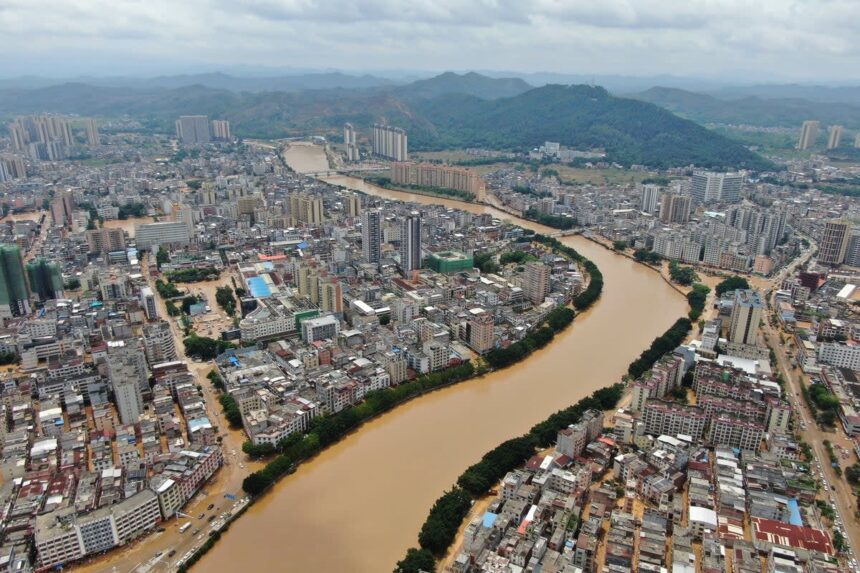BEIJING – Relentless heavy rain has devastated Huaiji County in Guangdong Province, South China, causing the worst floods seen in over 100 years. Local authorities blame Typhoon Wutip for the downpour, which has left much of the county underwater.
Streets in cities have become rivers, and farmland now looks like lakes. By 27 June 2025, tens of thousands had been forced to leave their homes. The disaster has led to major economic losses and highlighted the growing dangers of extreme weather in southern China, a region already facing more frequent and intense climate events.
On 18 June 2025, the Suijiang River in Huaiji reached an all-time high water level of 55.22 metres, exceeding the danger mark by over 5 metres. This was the fourth major flood this season, driven by weeks of heavy rain upstream.
On 17 June, the local emergency team issued the top-level flood warning and brought in strict measures, stopping schools, work, production, business, and most public activity except for basic services. Emergency shelters opened their doors, and people were told to stay inside as water swept through neighbourhoods and streets.
Videos on Facebook showed powerful muddy currents surging through Zhaoqing City. Cars were washed away, and entire streets disappeared under the water. On Weibo, residents described their struggles. One wrote, “Huaiji is now a water town.
Elderly and children in villages are stuck with no power and no phone service.” Another shared that driving through the downpour was like travelling through a waterfall, barely able to keep the car on the road.
Across Guangdong, over 300,000 people have been impacted, with 70,000 forced to evacuate. Around 68,000 of those are from Huaiji. Rescue teams have used storm boats to reach people trapped by the flood. In one case, Captain Chi Xiang’s team saved five people from a clinic, where water reached up to their chests. Another crew moved a 59-year-old man with limited mobility to safety at a local hospital.
Damage to the Economy and Infrastructure
The floods have taken a heavy toll on Huaiji’s economy, with direct losses at 41.26 million yuan (about $5.74 million), the local government reported. Roads, bridges, and power lines have all been damaged, and some areas have lost all basic services.
Across Guangdong, since April 2024, flooding has caused losses topping 140 million yuan ($20 million). In the Pearl River Delta, 36 homes have collapsed and 48 more have suffered severe damage.
Farmers have suffered the most, with the agricultural heart of China facing huge setbacks. In Qingyuan, farmer Huang Jingrong lost all his rice fields. “My fields are gone,” he said. The floods have hit during China’s rainy season, which usually runs from April to September.
This year, rain started earlier and was much heavier, often two or three times the normal level. Farmland has been swamped, reservoirs have been drained, and key infrastructure is at risk, threatening food supply and local jobs.
Southern China’s Ongoing Weather Struggles
Huaiji’s disaster is part of a wider pattern of severe weather in southern China. Guangdong, with its 127 million people and large manufacturing sector, has faced constant rain since April 2024.
The Pearl River Delta, including Guangzhou and Shenzhen, has seen record rainfall, with four stations logging all-time highs for April. At least 44 rivers in the region have gone above danger levels. The Bei River may soon reach a once-in-a-century flood, climbing 5.8 metres above its safety point.
The weather, made worse by a strong subtropical high and El Niño, has set off landslides, collapsed bridges, and cut power to more than a million households in Guangdong.
In Meizhou, June 2024’s floods and landslides led to at least 47 deaths. Jiaoling County alone estimated losses at 3.65 billion yuan ($502 million), while Meixian District faced 1.06 billion yuan ($146 million) in damages.
Climate experts say climate change is making such disasters more common and severe. Zheng Zhihai from the National Climate Centre explained that warmer sea temperatures in the South China Sea and Bay of Bengal are sending more moisture into southern China, causing bigger storms. Dr Faith Chan from the University of Nottingham Ningbo China added that although heavy rain is usual, the rapid pace of these storms points to a warming climate.
Response and What Lies Ahead
China’s response has been quick but challenging. The National Meteorological Centre issued red warnings for Guangdong, Guangxi, and other regions, marking maximum flood risk. Over 50,000 workers have been sent out to monitor embankments and shore up flood protection along major rivers. Huaiji alone received 60 million yuan in emergency funds for relief.
Despite these efforts, experts say old flood defences and fast urban growth in low-lying areas like the Pearl River Delta are not strong enough to cope with such fierce storms. Flooding costs China about 1.42 per cent of its annual GDP, far more than most other countries, stressing the need for better infrastructure.
As Huaiji and other parts of Guangdong get ready for even more rain, the future looks uncertain. The China Meteorological Administration warns that more extreme weather is likely, with heavy rain up to 80 mm forecast in parts of southern and central China soon. For people in Huaiji, the priority is to recover and stay safe, but the bigger task is adapting to a future of unpredictable and damaging weather.














